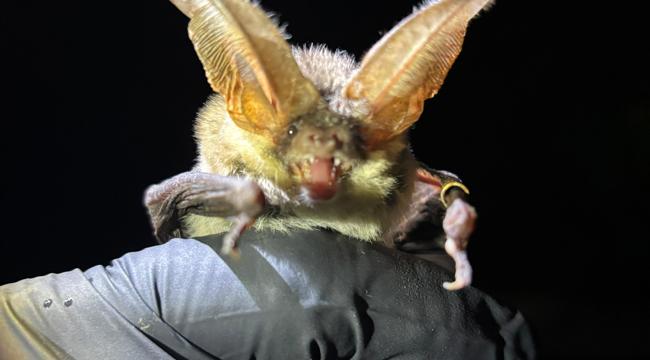Rare Grey Long-Eared Bat Discovered at Seaton Wetlands

A grey long-eared bat, one of the UK’s rarest mammals, has been recorded at Seaton Wetlands, confirming the species' presence at the site following a previous record in 2013.
The exciting discovery occurred after one of the Team’s popular bat walks, where members of the public enjoyed observing several bat species and listening to their distinctive echolocation calls using detectors.
After leading the event, Nature Reserves Ranger Ben Morgan-Brown joined international bat expert Professor Fiona Mathews, who was trapping onsite as part of migration study focused on tracking Nathusius’ pipistrelle. Although their target species wasn’t caught, the evening ended on a high when one of Fiona’s harp traps captured a female grey long-eared bat.
Identifiable by their exceptionally large ears and distinguishable from the more common brown long-eared bat by subtle features such as thumb size, grey long-eared bats are incredibly rare in the UK. Their population is estimated at fewer than 1000 individuals.
A habitat which has largely disappeared, Seaton Wetlands and a few other local patches of farmland in East Devon offer a species-rich wet grassland, supporting the moths, crane flies and midges which bats rely heavily to feed on, making it the perfect place for the grey long-eared to forage.
14 of the 16 bat species found in Devon have been recorded at the site, including other rarities such as Bechstein’s, greater horseshoe, and barbastelle.
Councillor Richard Jefferies, Portfolio Holder for Environment – Nature & Climate, said: “To find a grey long-eared bat at Seaton Wetlands is a fantastic accolade for the district and demonstrates the remarkable work the East Devon District Council Countryside Team undertake to support wildlife restoration and conservation at each of our nature reserves.”
Professor Fiona Mathews, Chair of Mammal Conservation Europe, added: “Bats are a vital part of our native wildlife. They are an indicator species, meaning their presence tells us a lot about the health of the environment. The diversity of bats at Seaton Wetlands is a strong sign of a thriving and healthy ecosystem, not just for bats but for a wide range of other wildlife and its fantastic to find a grey long-eared bat at the reserve for the second time.”
Nature Reserves Ranger, Ben Morgan-Brown reflected on the moment: “As I train towards my bat licence I’ve been lucky enough to encounter several rare species, but nothing will beat the moment I realised we were extracting a grey long-eared bat from the harp trap. To be able to handle and inspect such a rare species under Fiona’s supervision is an experience I’ll never forget.”
To find out more about upcoming Bat Walk events, visit: What's on
